

Learn Digital Skills, Prepare for Jobs, Grow Your Business - Grow with Google. Google IT Support Professional Certificate. Build Skills with Online Courses from Top Institutions. Intro to SQL: Querying and managing data. Cisco Networking Academy Builds IT Skills & Education For Future Careers. Networking Academy. Build your skills today, online. It’s Free. Coding Resources for Every Classroom.
Finch Robot Loan Program - BirdBrain Technologies. Dance. The Beginner's Guide to the Hour of Code. Coding in English Class? Yes! And in Your Class, Too! When the Hour of Code launched in 2013, I set aside my English curriculum for one day so my eighth graders could experiment with computer coding.
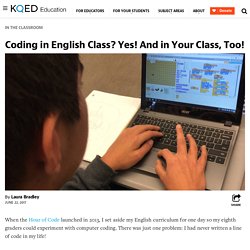
There was just one problem: I had never written a line of code in my life! Luckily, the Hour of Code offers more than 200 video tutorials for all ages and abilities. My students could choose hour-long tutorials with themes like Minecraft, Star Wars, Angry Birds, Frozen, Moana and more. Love music? There’s an Hour of Code tutorial for you. Three years later, I decided it was time to go deeper with coding, to incorporate it into a unit that would not just teach my students about coding but would also reinforce what they had been learning in my English class.
My students had spent most of the first semester writing their own novels (thanks to NaNoWriMo), so they were very familiar with the elements of a story. Next my students brainstormed ideas for computer games based on the novel they had just written. 15+ Ways of Teaching Every Student to Code (Even Without a Computer) According to Code.org, 90 percent of parents in the U.S. want their children to learn computer science—it will be crucial for many jobs in the near future—but only 40 percent of schools teach it. Critics claim that it is mainly the more affluent schools that offer computer science courses, thus denying those who attend poorer schools the chance to learn necessary skills. A focus on STEM is not enough: Code.org also reports that while 70 percent of new STEM jobs are in computing, only 7 percent of STEM graduates are in computer science.
It is imperative that savvy schools begin to focus some STEM resources on computer science and programming. Coding in the Classroom. In this Kahn Academy interactive online course, participants learn the basics of the JavaScript language to draw images and animations and beyond. Select from the Contents menu on the left, or scroll down the page.
Lessons are taught using short videos. Many videos have an interactive transcript and an error checker to assist you if you make a mistake. Use the provided links to videos hosted on YouTube. After viewing the explanation or a concept, try the practice sessions. Tag(s): animation (60), coding (69), computers (102), critical thinking (117), problem solving (293) In the Classroom The course is self-paced, so differentiation is easy. 3 Cool Ways Coding Builds Kids' Critical Thinking. Teach Your Students to Code and Why It Helps. Children are our future.
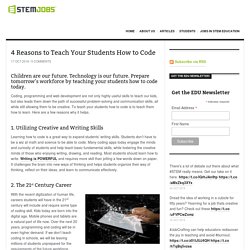
Technology is our future. Prepare tomorrow’s workforce by teaching your students how to code today. 9 Reasons Why Kids & Teens Should Learn to Code. Over the last few years, you might have asked yourself at least once, “What’s with all the hype about getting kids into coding?”
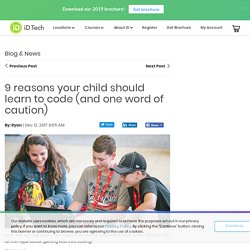
I hear you! But first, let me say it’s not just hype. But even before that, let's define some things. Important Skills Kids Learn Through Coding. Coding is the future.

I’m an instructional technology coordinator for Newton County Schools in Covington, Georgia, and I strongly believe in teaching our students the power of coding. Pretty much everything that kids touch involves coding these days—their remote controls, TVs, phones, watches—we are a technological society, and it’s only going to increase in the future. I definitely don’t claim to be a tech pro—if something breaks, I immediately call tech support to get it fixed.
But I do believe in coding and making it part of a child’s curriculum. In recent years I’ve been working with a lot of new teachers who are unsure about how to integrate technology in their classrooms. However, once you realize how much technology can aid your other curricula, you see that it’s worth the time and energy. 1. Minecraft. Techrepublic. This device is unable to play the requested video.
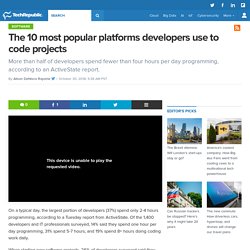
On a typical day, the largest portion of developers (37%) spend only 2-4 hours programming, according to a Tuesday report from ActiveState. MakeCode. Unsupported configuration - Microsoft MakeCode. Grasshopper: Learn to Code for Free - Apps on Google Play. Welcome to Grasshopper, the coding app for beginners.
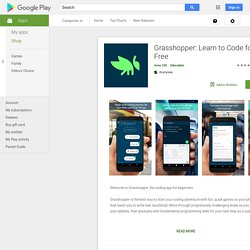
Grasshopper is the best way to start your coding adventure with fun, quick games on your phone that teach you to write real JavaScript. Move through progressively challenging levels as you develop your abilities, then graduate with fundamental programming skills for your next step as a coder. * Visual puzzles develop your problem-solving skills and solidify coding concepts* Use industry-standard JavaScript with just a few taps on your phone* Real-time feedback guides you like a teacher* Collect achievements as you learn new skills Get started programing today! We can’t wait to meet you. ISTE-EdTech Coaches Network-District Coding Plan. The 5th ‘C’ of 21st Century Skills? Try Computational Thinking (Not Coding) Free Technology Curriculum from Google - Applied Digital Skills. Made with Code. X-Ray Goggles Help Students See How Webpages Are Made. Kids Design and Build Their Own Apps. Login.
ISTE-CTN - Monthly Newsletter Readings. Skip to main content Get your brand new Wikispaces Classroom now and do "back to school" in style.
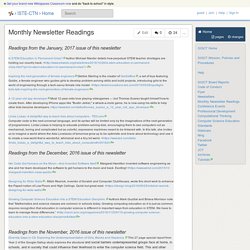
CS for All Teachers. Getting Started with MIT App Inventor 2. Kodable: Programming Curriculum for Elementary. Computational Thinking. Google CS First. Google+ Learn. Play, Design & Code Retro Arcade Games Grades 2+ | Blocks CS First Unplugged. VR, PBL, and OERs: Four High Hopes for Learning with Edtech in the New School Year. Using technology in schools is no longer just about preparing our students for college and career.

Not only do they need the skills to navigate and utilize technology, but they need to understand how technology can connect them with people, places, and resources that were previously unreachable. In 2014, I wrote about strategies for edtech success in the new school year, and in 2015, I wrote about edtech teaching trends for the new school year. Well, I’ve spotted some tools and strategies that have amazing potential to empower students and teachers to engage and learn more with the world beyond their school. So this year, I’m sharing my high hopes for how some of the new powerful tools out there could be used in your school or classroom. High Hope #1: Student-Created VR (Virtual Reality) and AR (Augmented Reality) Where we are: The buzz around virtual and augmented reality is hard to ignore.
6 STEAM tinkering tools for the holidays. Engage kids of all ages with these STEM and coding learning toys The year that was brought with it a renewed, and much welcome, interest in science and technology, as STEAM, makerspaces, 3D printing, and coding all became hot topics.
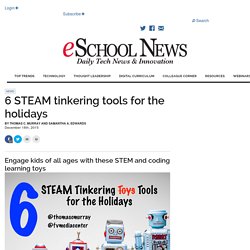
Each year, as parents look to celebrate the various holidays with our kids, many of us rack our brains trying to find gifts that are both fun and educational. This year is no different and fortunately, the latest STEAM push has made many of the learning tools very desirable as holiday gifts. The following are six ed-tech tools that will undoubtedly spark the creative and innovative side of kids of all ages (parents and teachers included). SCRATCHing the surface of Coding with your students. Jeffrey Bradbury Jeffrey Bradbury, author of Kidblog: An Introduction to Blogging With Your Students, is the creator of TeacherCast.net, TeacherCast University, and Educational Podcasting Today, is a Google Certified Teacher, Google Education Trainer, PBS Learning Media Digital Innovator, speaker, writer, broadcaster, consultant and educational media specialist.
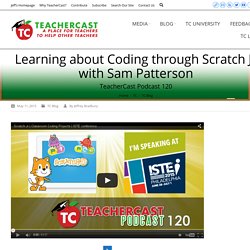
In 2012, Jeff was recognized as one of top 50 educators using social media at the first ever Bammy Awards and has been nominated twice in the category of Innovator of the Year. Jeff has Keynoted for the Pearson Authentic Learning Conference, EdTechNJ and most recently at Columbia Universities Teacher College.
Additionally the TeacherCast Educational Broadcasting Network has served educational conventions worldwide by providing on site live broadcasting to thousands of educators each week. Jeff is the host of the TeacherCast Podcast, Educational Podcasting Today and the TechEducator Podcast. Ready to Learn Coding? Here are resources. Plus: Teaching with Scratch. There are several ways to start learning about code, and each offers something a little different.
Not all coding sites are created equal, and not every site or initiative works for every teacher or learner. A playful, introductory experience might not satisfy a teacher looking for a civic-minded coding experience, while an in-depth tutorial on programming games might not be the best starting place for a kid interested in web design. Code Avengers: learn to code games, apps and websites. Learn code. Learn math.